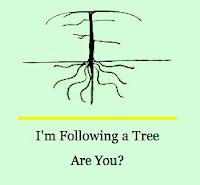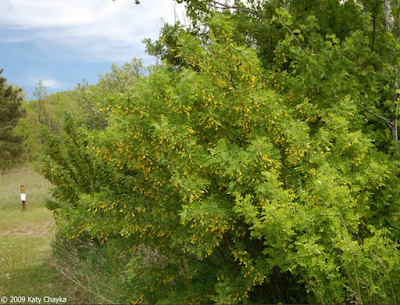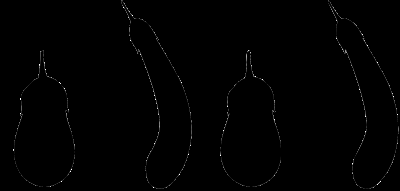
A legume is a fruit type specific to the pea family. When dry, it splits on two sides to release seeds.
Continuing my journey through the South Dakota sylva, this month I'm following (learning about) our four leguminous trees—members of the Legume or Pea Family (Fabaceae). However I wanted to include all three subfamilies and their interesting flowers, so I'm throwing in a vine as well (1).I will start with the largest—the pea subfamily or Faboideae, represented by two tree species in SD.
Siberian Peashrub—some love it, some hate it; MWI.
The Siberian Peashrub, Caragana arborescens, is native to Siberia and parts of China and central Asia. It probably was introduced by settlers on the prairies of North America, where it continues to be recommended for shelterbelts (windbreaks). It's easily grown in harsh habitats, is a nitrogen-fixer, and provides wildlife habitat. But sometimes it grows too easily and is a noxious weed, for example where it takes over prairie via shading, or provides cover for predators adjacent to habitat for prairie birds, considered one of the most threatened groups of birds in North America (Carter & Johnson 2022).Like most leguminous trees, Siberian Peashrub has pinnately compound leaves—divided into leaflets arranged in pairs. Usually the base of the leaf stalk is armed with a pair of spines.
Jamie Nielsen, U. Alaska Fairbanks (labels added).
Being a member of the Faboideae, Peashrub flowers have petals arranged as in typical pea flowers: a broad ± upright banner, 2 lateral wings, and 2 lower petals united to form a keel. Hidden inside the keel are 10 stamens and a pistil, making the flowers bisexual.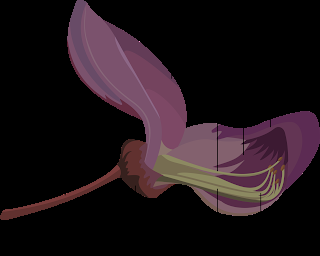
A "typical pea flower" with 2 petals removed to show stamens and pistil; source.
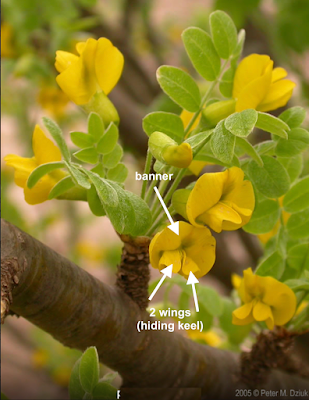
Siberian Peashrub flowers; MWI (labels added).
Seeds are contained in legumes (aka pods), as is the case for almost all members of the Fabaceae (hence the old family name Leguminosae). Shape and size can vary greatly among genera and species.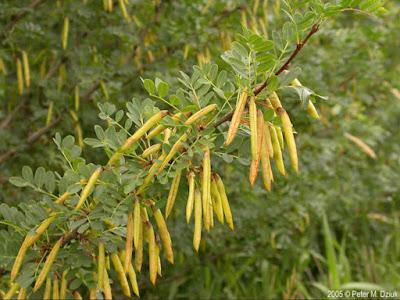
Siberian Peashrub legumes; MWI.
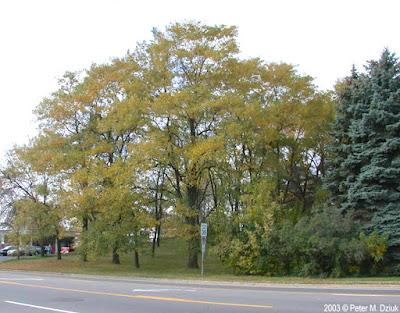
Black Locust in full fall color; MWI.
Black Locust, Robinia pseudoacacia, may have originally been restricted to the Allegheny Mountains in the eastern US, but it has been widely planted, becoming naturalized and obscuring its original range. Like the Siberian Peashrub it has pinnately compound leaves often with a pair of spines at the base of the stalk. But the Black Locust has an odd number of leaflets (note the terminal leaflet below), whereas Peashrub has an even number.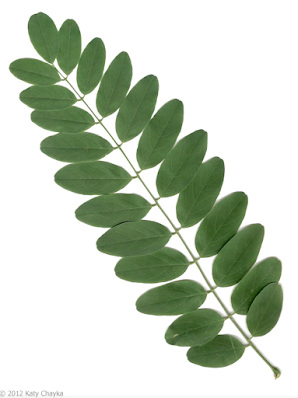
Black Locust leaves can reach 30 cm in length; MWI.
Black Locust belongs to the Faboideae, so its flowers are typical pea flowers—with banner, wings and keel. They're arranged in elongate pendulous clusters, and are both fragrant and lovely.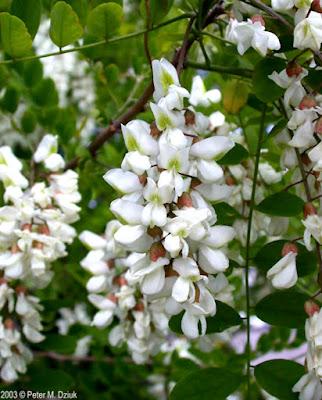
Black Locust flowers—note greenish patch at base of banners; MWI.
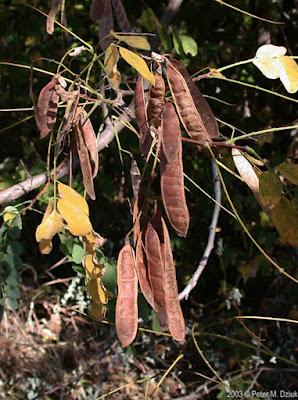
Black Locust legumes late in the season; MWI.
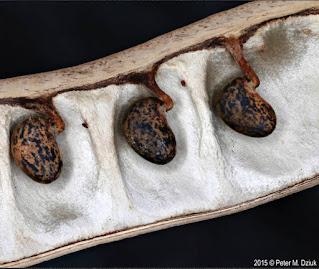
Black Locust's mottled seeds; MWI.
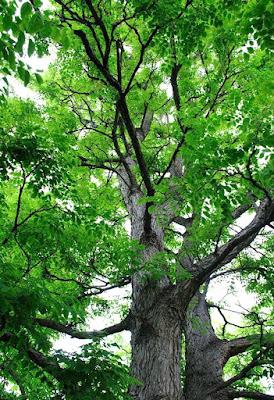
Kentucky Coffeetree is SD's only known native leguminous tree (Vern Wilkens photo).
The Kentucky Coffeetree, Gymnocladus dioicus, is native to the eastern and central US, including the southeast corner of SD. It's one of two SD trees in the Caesalpinoideae. As is common in this subfamily, the leaves are twice compound—both leaves and leaflets are pinnately divided.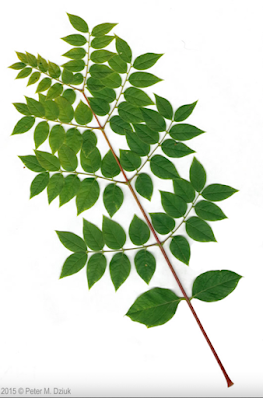
A single Coffeetree leaf, twice compound except for a pair of simple leaflets at the base; MWI.
Some members of the Caesalpinoideae have flowers with specialized petals, somewhat like those of the Faboideae. In others the flowers are regular, with undifferentiated petals. SD trees fall into the latter group.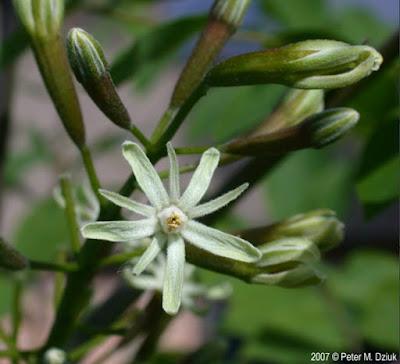
Kentucky Coffeetree flowers have 5 slender petals and even narrower sepals; MWI.
As the species name—dioicus—indicates, flowers are unisexual with male and female flowers on separate trees (dioecious). Rarely flowers are bisexual.Legumes of the Coffeetree are large and leathery, with very hard seeds nestled in sticky toxic pulp. Native Americans and early settlers roasted and ground the seeds for a drink reminiscent of coffee (no caffeine). But the seeds are highly toxic prior to roasting, so don't eat them straight from the tree!
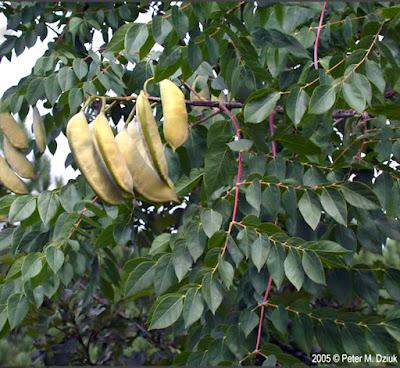
Kentucky Coffeetree legumes, to 15 cm long; MWI photo.
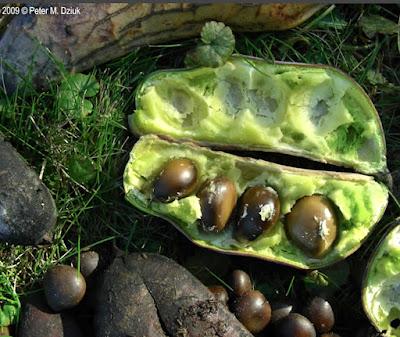
Seeds c. 1 cm long; they're highly toxic unless roasted, and the "coffee" isn't all that great; MWI.
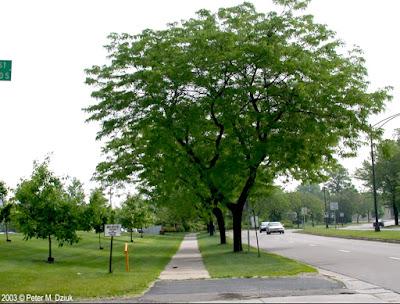
Thornless Honey Locusts (var. inerme) are popular in landscaping; MWI.
The other SD tree in the Caesalpinoideae is the Honey Locust, Gleditisia triacanthos. It's native to North America but probably not to SD; however widespread planting and escapees have obscured its original range. Leaves can be once or twice compound, even on the same tree.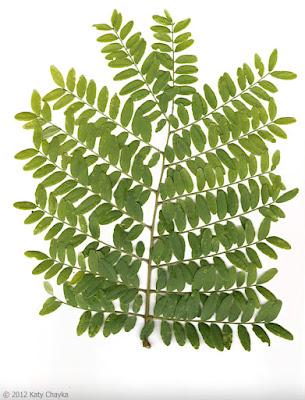
One Honey Locust leaf, this one twice compound; MWI.
Trunks of wild Honey Locusts (not cultivars) have downright nasty thorns to 20 cm long (2). These are often 3-branched, explaining the species name, triacanthos (3 thorns). Fortunately there are thornless varieties. These are popular for landscaping, especially where shade is needed quickly. They transplant easily, grow rapidly, and can tolerate harsh site conditions.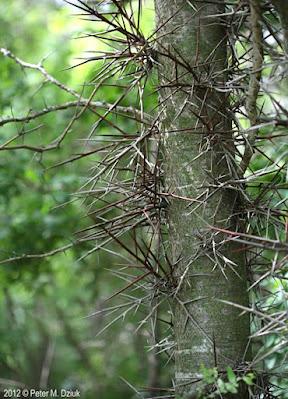
Yikes!! MWI.
Like Coffeetree flowers, those of Honey Locust are regular and unisexual, with male and female flowers on different trees (dioecious), or sometimes on different branches of a single tree (monoecious). Rarely flowers are bisexual, for example in the photo below.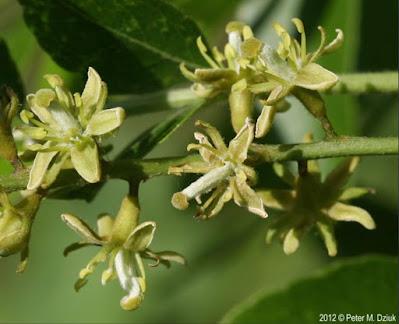
Honey Locust flowers, both female and bisexual; MWI.
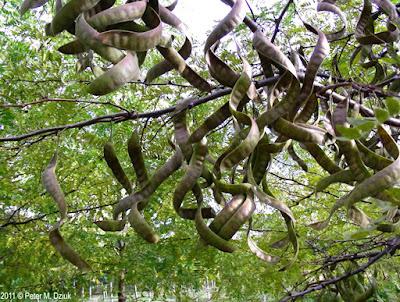
Nicely arranged Honey Locust legumes; MWI.
As promised, I'm including a non-tree to illustrate flowers of the third legume subfamily, the Mimosoideae. Nuttall's Sensitive Brier, Mimosa nuttallii, is a sprawling or climbing subshrub (woody only at base) native to the central US including SD.
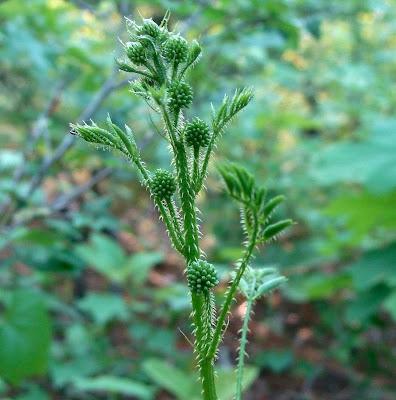
In its youth (growth of the season), Nuttall's Sensitive Brier shows the beauty of prickles! ANPS.
These briers are heavily armed with curved prickles, allowing them to climb if support is available nearby (otherwise they sprawl on the ground). Humans find the prickles quite painful to touch, yet Nuttall's Sensitive Brier is desirable forage for wildlife and cattle, and can be wiped out with overgrazing.The leaves are twice-compound, and the ultimate segments are quite slender, especially when touched, for they fold longitudinally in response! They are quite sensitive, closing in just a few seconds. They later relax until the next time they are tickled, when they again quickly fold (more about Mimosa's muscles here).
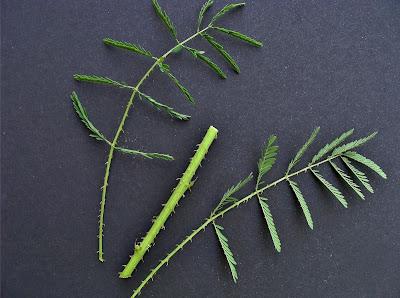
Two twice-compound leaves of Nuttall's Sensitive Brier, with segments mostly closed; ANPS.
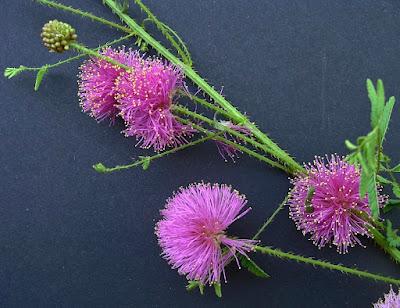
Flowers in each head open simultaneously, but heads bloom progressively (upwards); ANPS.
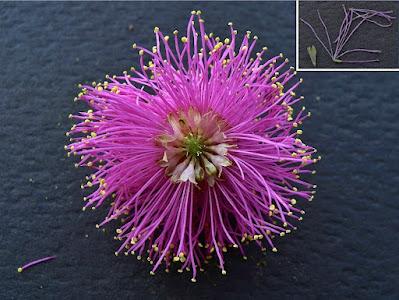
Mimosa nuttallii head from below (stem removed); note tiny flowers with outrageous stamens! ANPS.
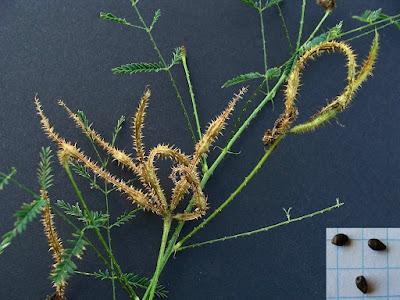
Mimosa nuttallii legumes are ridged, with prickles along the ridges; ANPS.
And so we come to the end of this month's tour. For those readers still with me, thanks for being a traveling companion! Hopefully next month I will have photos of SD trees in person (should that be "in plant"?). April was too rainy. May looks promising.
Notes
(1) Recently the three long-standing subfamilies of the Fabaceae were split, shuffled and rearranged in ways still being debated. For more see Fabaceae, Phylogeny and Taxonomy in Wikipedia; and The Legume Phylogeny Working Group. 2017. A new subfamily classification of the Leguminosae based on a taxonomically comprehensive phylogeny. Taxon 66:44–77.
(2) For the botanically curious, the sharp-pointed structures on the trunk of the Honey Locust technically are thorns rather than spines because they are modified shoots (able to branch). See Wikipedia's wonderful article devoted to the intricacies of thorns, spines and prickles.
Sources
Arkansas Native Plant Society. 2018. Know Your Natives – Sensitive Brier. Photos CC BY_NC 3.0 (non commercial use with attribution). An excellent website.
Johnson, WC, and Knight, DH. 2022. Ecology of Dakota Landscapes. Yale University Press.
MFI. Minnesota Wildflowers; a field guide to the flora of Minnesota. A terrific source of information and photographs for the many plants shared with South Dakota.
This is my contribution to the May gathering of tree followers, kindly hosted by The Squirrelbasket.
